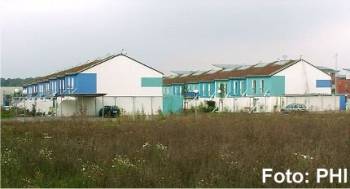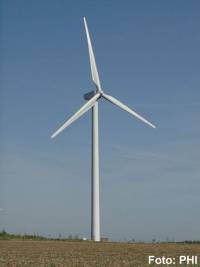Renewable sources of energy
There are great potentials in improving efficiency, and in addition, energy efficiency and renewable energy go hand in hand for solving the issue of climate protection.
The Passive House is a perfect example for this:
- more than a third of the total energy consumption of a Passive House in a typical cool moderate climate can be covered by hot water collectors – because a Passive House requires more energy for the generation of hot water than it does for the heating. Thermal collectors are the best solution for the provision of hot water. (The figures are even better in warm moderate climates and in “lucky climates like California: it could be 50% to full cover.)
- The remaining demand is so small in Passive Hosues that it can be met in a fully cost-effective way by renewable energy, e.g. by buying a share in a wind power plant – this has already been implemented in practice (example in illustration).
- Photovoltaic systems can also contribute significantly to the supply of energy in Passive Houses. But let us be honest: The contribution of photovoltaic systems to “ordinary” inefficient houses with high consumption values is no more than a “fig leaf”; but Passive House efficiency makes the difference.
Due to the very high energy efficiency of the Passive House, there are increased opportunities for an adequate supply of energy though renewable sources. For one thing, the technical prerequisites are excellent: with low consumption even minimal power supplies are sufficient; and smaller power densities are a characteristic of renewable energy sources; for another thing, the cost-efficient implementation takes place in a better way: if the energy consumption is very low, the price for a kilowatt hour of conventional energy supply will usually be relatively high. In the Passive House, however, this doesn't matter because the consumption is so small that even high prices become bearable. That is the economic opportunity for renewable energy: the price per kilowatt hour is still high, but in a Passive House the user can afford it without any problem. Therefore the use of renewable energy with high energy efficiency is economically more attractive in relation to the conventional supply of energy.
The more the “renewable energy sources and efficiency” objectives are actually implemented, the more significant the effects will be:
- less burden on social funds (through noticeably increased employment)
- additional tax revenue (due to added value)
- increase in buying power (due to less energy costs)
- the reduction in CO2 emission.




